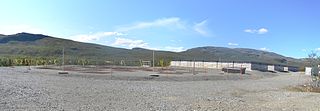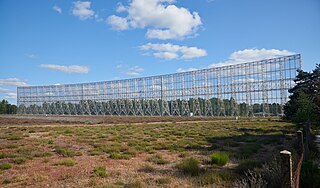LOFAR may refer to:
- Low-Frequency Array, a large radio telescope system based in the Netherlands
- Low Frequency Analyzer and Recorder and Low Frequency Analysis and Recording, for low-frequency sounds
LOFAR may refer to:

The Square Kilometre Array (SKA) is an intergovernmental international radio telescope project being built in Australia (low-frequency) and South Africa (mid-frequency). The combining infrastructure, the Square Kilometre Array Observatory (SKAO), and headquarters, are located at the Jodrell Bank Observatory in the United Kingdom. The SKA cores are being built in the southern hemisphere, where the view of the Milky Way galaxy is the best and radio interference is at its least.

Birr Castle is a large castle in the town of Birr in County Offaly, Ireland. It is the home of the 7th Earl of Rosse and his family, and as the castle is generally not open to the public, though the grounds and gardens of the demesne are publicly accessible, and include a science museum and a café, a reflecting telescope which was the largest in the world for decades and a modern radio telescope.

Onsala Space Observatory (OSO), the Swedish National Facility for Radio Astronomy, provides scientists with equipment to study the Earth and the rest of the Universe. The observatory operates two radio telescopes in Onsala, 45 km south of Gothenburg, and takes part in several international projects. Examples of activities:

Electromagnetic interference (EMI), also called radio-frequency interference (RFI) when in the radio frequency spectrum, is a disturbance generated by an external source that affects an electrical circuit by electromagnetic induction, electrostatic coupling, or conduction. The disturbance may degrade the performance of the circuit or even stop it from functioning. In the case of a data path, these effects can range from an increase in error rate to a total loss of the data. Both human-made and natural sources generate changing electrical currents and voltages that can cause EMI: ignition systems, cellular network of mobile phones, lightning, solar flares, and auroras. EMI frequently affects AM radios. It can also affect mobile phones, FM radios, and televisions, as well as observations for radio astronomy and atmospheric science.

The Low-Frequency Array (LOFAR) is a large radio telescope, with an antenna network located mainly in the Netherlands, and spreading across 7 other European countries as of 2019. Originally designed and built by ASTRON, the Netherlands Institute for Radio Astronomy, it was first opened by Queen Beatrix of The Netherlands in 2010, and has since been operated by ASTRON on behalf first of the International LOFAR Telescope (ILT) partnership and now of the LOFAR ERIC by ASTRON.

Leviathan of Parsonstown, or Rosse six-foot telescope, is a historic reflecting telescope of 72 inches (1.83 m) aperture, which was the largest telescope in the world from 1845 until the construction of the 100-inch (2.5 m) Hooker Telescope in California in 1917. The Rosse six-foot telescope was built by William Parsons, 3rd Earl of Rosse on his estate, Birr Castle, at Parsonstown in Ireland.
LORUN stands for LOFAR at Radboud University Nijmegen. It is a radio telescope based on antennas designed for the THETA test station for the LOFAR radio telescope. This project is also closely related to the LOPES Project, it uses the data acquisition program originally designed for LOPES.

The Dwingeloo Radio Observatory is a single-dish radio telescope near the village of Dwingeloo in the northeastern Netherlands. Construction started in 1954, and the telescope was completed in 1956. The radio telescope has a diameter of 25 m. At the time of completion it was the largest radio telescope in the world, but it was overtaken in 1957 by the 250 foot (76 m) Lovell Telescope.

ASTRON is the Netherlands Institute for Radio Astronomy. Its main office is in Dwingeloo in the Dwingelderveld National Park in the province of Drenthe. ASTRON is part of the institutes organization of the Dutch Research Council (NWO).

Exloo is a village in the province of Drenthe, Netherlands, part of the municipality of Borger-Odoorn. It lies about 12 km north of Emmen.

The Medicina Radio Observatory is an astronomical observatory located 30 km from Bologna, Italy. It is operated by the Institute for Radio Astronomy of the National Institute for Astrophysics (INAF) of the government of Italy.
Harvey Raymond Butcher III is an astronomer who has made significant contributions in observational astronomy and instrumentation which have advanced understanding of the formation of stars and of the universe. He received a B.Sc. in Astrophysics from the California Institute of Technology in 1969, where he contributed to the development of advanced infrared spectrometry applied in the first survey of the sky at infrared wavelengths.
The Long Wavelength Array (LWA) is a radio telescope in central New Mexico. It began preliminary tests of the hardware in 2011, and began regular operations in late 2015. It is one of the few observatories to utilize relatively low frequencies (10-88 MHz), and is used to study relativistic particles, cosmic evolution, astrophysical plasma, decametric radio emissions from Jupiter-like extrasolar planets, and giant flares from magnetars.
The Large-Aperture Experiment to Detect the Dark Ages (LEDA) is designed to detect the spectrum of the 21 cm Hydrogen line from the Intergalactic Medium (IGM) at redshifts of 15–30, when the Universe was just ~1% of its present age. It is located at the Long Wavelength Array site, adjacent to the Very Large Array. LEDA principally comprises a "large-N" array correlator, calibration & imaging system, and instrumentation for measurement of calibrated total-power. These systems will use the station 1 of the Long Wavelength Array as an aperture. LEDA will feature array-based calibration to improve the accuracy of foreground subtraction from the total-power signal.

The Kilpisjärvi Atmospheric Imaging Receiver Array (KAIRA) is an astronomical observatory operated by the Sodankylä Geophysical Observatory on behalf of Oulu University. It is located at Kilpisjärvi, Enontekiö near the border with Norway. It comprises two LOFAR-derived radio telescope systems and is capable of observing at HF and VHF radio frequencies. It is used for atmospheric, near-Earth space and astronomical research. KAIRA uses LOFAR phased-array antennas and digital signal-processing hardware. The phased array configuration has no moving parts and with digital control, allows KAIRA to quickly scan the sky, giving KAIRA a large field of view. KAIRA can produce a continuous all-sky image of the radio transparency of ionosphere, using cosmic radio noise for "illumination" (riometry). KAIRA can also obtain electron density profiles in the atmosphere. This allows the study of the interaction of the solar wind with the atmosphere, such as in aurora borealis and other space weather phenomena. In addition to near-space imaging, the use of KAIRA has been demonstrated for long-baseline interferometry observations of pulsars.

URAN is an array of radio-telescopes, spread across Ukraine and used for long-baseline interferometry in the 8-40 MHz range. The most sensitive of the telescopes is UTR-2; URAN-1 and URAN-2, URAN-3 is near Shatsk, in the north-west corner of Ukraine by the point where Poland and Belarus meet Ukraine, and URAN-4 is in the south-west, a little west of Odesa and by the Moldovan border.

The Nançay Radio Observatory, opened in 1956, is part of Paris Observatory, and also associated with the University of Orléans. It is located in the department of Cher in the Sologne region of France. The station consists of several instruments. Most iconic of these is the large decimetric radio telescope, which is one of the largest radio telescopes in the world. Long established are also the radio heliograph, a T-shaped array, and the decametric array operating at wavelengths between 3 m and 30 m.
Low Frequency Analyzer and Recorder and Low Frequency Analysis and Recording (LOFAR) are the equipment and process respectively for presenting a visual spectrum representation of low frequency sounds in a time–frequency analysis. The process was originally applied to fixed surveillance passive antisubmarine sonar systems and later to sonobuoy and other systems. Originally the analysis was electromechanical and the display was produced on electrostatic recording paper, a Lofargram, with stronger frequencies presented as lines against background noise. The analysis migrated to digital and both analysis and display were digital after a major system consolidation into centralized processing centers during the 1990s.

Alcyoneus is a low-excitation, Fanaroff–Riley class II radio galaxy located 3.5 billion light-years from Earth, with host galaxy SDSS J081421.68+522410.0. It is located in the constellation Lynx and it was discovered in Low-Frequency Array (LOFAR) data by a team of astronomers led by Martijn Oei. As of 2024, it has the second-largest extent of radio structure of any radio galaxy identified, with lobed structures spanning 5 megaparsecs across, described by its discoverers at the time as the "largest known structure of galactic origin." It has since been superseded by another radio galaxy, Porphyrion, with lobed structures of 7 megaparsecs.

PSR J0952–0607 is a massive millisecond pulsar in a binary system, located between 3,200–5,700 light-years (970–1,740 pc) from Earth in the constellation Sextans. It holds the record for being the most massive neutron star known as of 2022, with a mass 2.35±0.17 times that of the Sun—potentially close to the Tolman–Oppenheimer–Volkoff mass upper limit for neutron stars. The pulsar rotates at a frequency of 707 Hz, making it the second-fastest-spinning pulsar known, and the fastest-spinning pulsar known within the Milky Way.